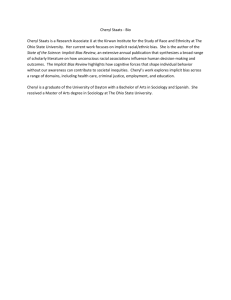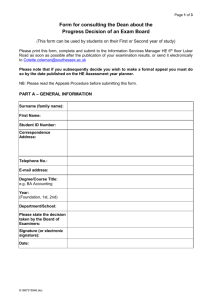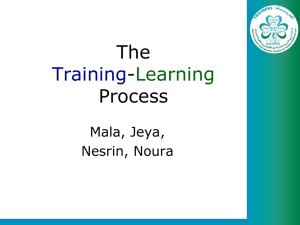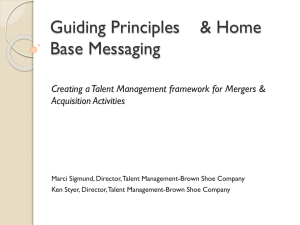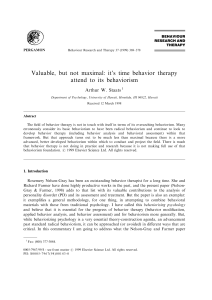Evaluation tools for racial equity
advertisement
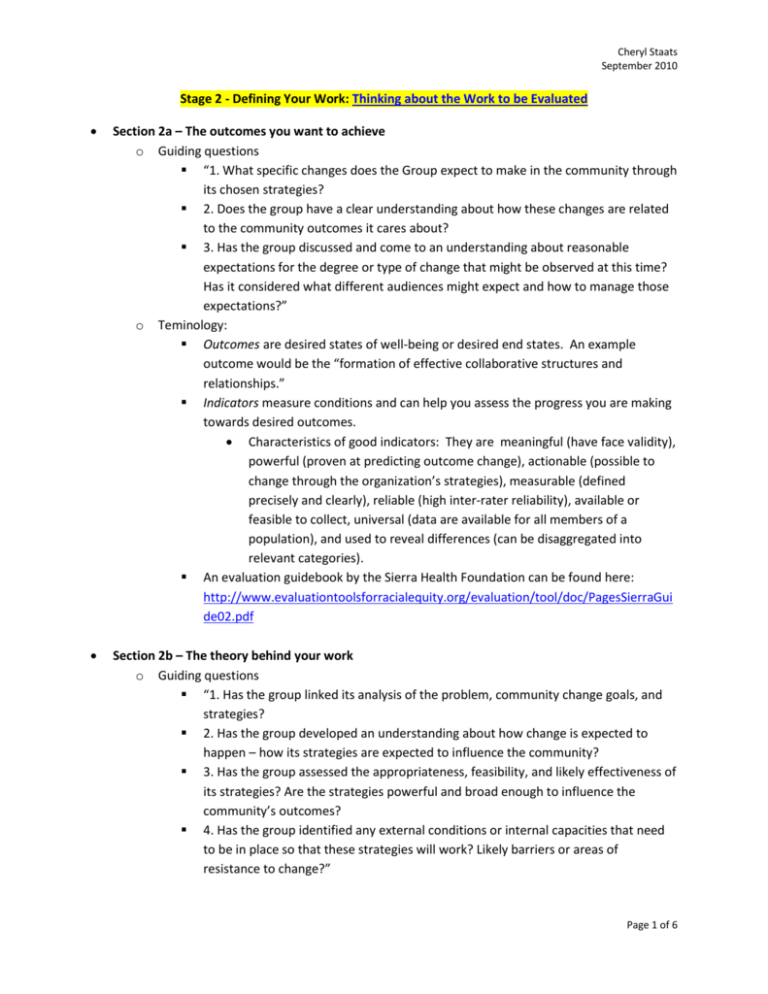
Cheryl Staats September 2010 Stage 2 - Defining Your Work: Thinking about the Work to be Evaluated Section 2a – The outcomes you want to achieve o Guiding questions “1. What specific changes does the Group expect to make in the community through its chosen strategies? 2. Does the group have a clear understanding about how these changes are related to the community outcomes it cares about? 3. Has the group discussed and come to an understanding about reasonable expectations for the degree or type of change that might be observed at this time? Has it considered what different audiences might expect and how to manage those expectations?” o Teminology: Outcomes are desired states of well-being or desired end states. An example outcome would be the “formation of effective collaborative structures and relationships.” Indicators measure conditions and can help you assess the progress you are making towards desired outcomes. Characteristics of good indicators: They are meaningful (have face validity), powerful (proven at predicting outcome change), actionable (possible to change through the organization’s strategies), measurable (defined precisely and clearly), reliable (high inter-rater reliability), available or feasible to collect, universal (data are available for all members of a population), and used to reveal differences (can be disaggregated into relevant categories). An evaluation guidebook by the Sierra Health Foundation can be found here: http://www.evaluationtoolsforracialequity.org/evaluation/tool/doc/PagesSierraGui de02.pdf Section 2b – The theory behind your work o Guiding questions “1. Has the group linked its analysis of the problem, community change goals, and strategies? 2. Has the group developed an understanding about how change is expected to happen – how its strategies are expected to influence the community? 3. Has the group assessed the appropriateness, feasibility, and likely effectiveness of its strategies? Are the strategies powerful and broad enough to influence the community’s outcomes? 4. Has the group identified any external conditions or internal capacities that need to be in place so that these strategies will work? Likely barriers or areas of resistance to change?” Page 1 of 6 Cheryl Staats September 2010 o o o “Evaluators often ask groups to create two tools: one is called ‘a theory of change’ and the other is called a ‘logic model.’” Theory of change- a pathway or series of steps that culminate in change. The group has to understand the assumptions they are making behind their theory of change. Group members are able to see whether they have included all of the steps necessary for change, allowing for dialogue regarding what steps are in fact necessary. “Once a theory of change is developed for a strategy, one of its main benefits is helping identify expected results along the way to the hoped-for community change.” A logic model – “is usually in the form of a chart. The chart also lists the steps that the group is planning to implement, usually as particular activities or strategies. The chart also lists what the group thinks the important results of those steps will be, usually in the form of short-term, intermediate and long-term outcomes.” This helps groups working towards social equity, antiracism, and inclusion goals a way to discuss different groups’ assumptions about what is success so that reasonable expectations can be created. Logic models help evaluation because they lay out outcomes in varying intervals that can be used to measure progress. Logic Model development guide from the W.K. Kellogg Foundation: http://www.evaluationtoolsforracialequity.org/evaluation/tool/doc/pub366 9.pdf Online logic model building tool from University of Wisconsin: http://www.uwex.edu/ces/lmcourse/# Being able to measure interim results/progress is important since much anti-racism work is long-term. Strategies – “sets of activities, services, or programs that are intended to accomplish the same ends.” Example: “Conducting a public awareness and education campaign about racial disparities in educational opportunities and outcomes is a strategy. Activities that may be part of that strategy include public service announcements on radio and television, editorials and commentary in print media, a web site, presentations at public meetings, distribution of a community report card, etc.” Questions to help the group pick strategies and activities that have the best likelihood of success and the biggest potential impact: “Are the specific ways in which our strategies address the identified problems and contribute to the desired outcomes clearly spelled out? Is there a well-described pathway from each activity or program to its expected immediate effects, and from these effects to the next expected change, and so on? Page 2 of 6 Cheryl Staats September 2010 o o Do we have evidence -- from research, from best practices, or from experience -that suggests that the activities or programs of our strategies (if they are implemented well), and their effects, will make a difference in the ways we expect? Is the strategy going to be implemented broadly, with sufficient quality, intensity and duration, to make a difference in what you will be able to observe about the expected effects? Have external factors that might weaken our strategies or lessen their effects been identified? What has been done to address these factors, or to reduce their consequences, if that is possible? If not possible, what information will be available to take these factors into consideration when evaluating the success of our strategies?” Six Stages of Change1: Community change is rarely linear; it’s important monitor trends, use multiple methods of observation and change documentation, and evaluate strategies at multiple points in time. “The theory of change for anti-racism work should include strategies for anticipating, identifying and addressing resistance in the community. That will not only improve the work's overall effectiveness, but also allow the evaluation to include these strategies in its assessment.” Section 2c – The evaluation questions to be answered o Guiding questions: “1. Who are the most important audiences for evaluation findings and what does each want to know? 2. What questions does the group need to answer about how well or broadly its chosen strategies are being carried out? 1 “Long Term Anti-Racism Strategies: A Guide to Developing Effective Community Projects.” (2001) Affiliation of Multicultural Societies and Service Agencies of BC, http://www.evaluationtoolsforracialequity.org/evaluation/tool/doc/ltars.pdf Page 3 of 6 Cheryl Staats September 2010 o o o o 3. What questions does the group need to answer about whether and how its strategies are making a difference in the specific things it is trying to change immediately in the community?” Why measure a group’s programs and activities? Descriptive – for a report or historical record Check on its operations and use of resources “Assess whether it was possible to carry out the intended activities and programs and reach and engage the intended individuals or groups.” Data that you may want/need to include: Activities – Which ones occurred? “When? In what order? By whom? Using what resources? Targeted to which individuals or groups, and to how many? Reaching which individuals or groups, and how many?” Services or programs – Which were delivered? “How many? By whom? To whom? When? Where? How many of the intended set of individuals or groups received any services or participated in any way? What was the intensity or ‘dose’ of what they received? That is, how much service or support did they receive on average, or how long did they participate on average? How many were considered to have completed the program or received the appropriate amount of services?” “Evaluation of implementation and participation should be planned for those activities and programs that meet one or more of the following conditions: Are critical to the overall success of the strategy Require substantial resources Are highly visible Are innovating or involve significant changes to a proven effort “Evaluation questions about the implementation of activities and programs tend to focus on the “why” of implementation success or failure and how this relates to the difference the programs or activities made on the things the group hopes to change.” Stage 3 - Designing: Evaluation Design and Plan Section 3a – Evaluation design o Guiding questions: “1. What kinds of information are needed to answer the evaluation questions? What information about the community outcomes of interest does the group need to track? 2. What type of evidence is needed to: a. demonstrate that the desired community changes are happening? b. evaluate the success of the group’s chosen strategies and activities? c. assess whether or to what extent the group’s strategies are contributing to community change? Page 4 of 6 Cheryl Staats September 2010 o o o o 3. Have issues of cultural competence been considered in developing the evaluation design?” Evaluation can be expensive, so there’s a need to compromise between the evaluation goals and rigor and evaluation cost. General rule of thumb: Evaluations should cost approximately 10% of total project budget Things to consider when deciding how much effort and resources to expend on evaluation: What evaluation questions need answered now? It can be important to measure implementation (make sure strategies are reaching the right people), but if you have to choose, devoting resources to measuring results rather than implementation is likely to be preferable. “What decisions will be made from evaluation information and what are the consequences of those decisions for your constituencies? Have the strategies of the group been in place long enough for their implementation to be assessed and/or to make it likely that their effectiveness can be evaluated? What do key stakeholders expect regarding the type and quality of evidence from the evaluation? What research or evaluation expertise and skills do members of the group have or can draw on from within the community? What data are already available for the evaluation?” Many factors can combine to create community change, so when changes in the community are observed, it is both important and difficult to judge whether the change was the result of a strategy that was implemented or other factors. Although a control group evaluation design is often the “gold standard” in the social sciences, it is often not possible to create. But there are other evaluation designs: Comparison group design – Matching subjects who are involved in an intervention/strategy with people of similar characteristics who are not involved. This isn’t as good as a control group design, because other differences between the groups may interfere in the analysis. Pre-post observations – This design measures change in a group, but it can be unclear whether the same change would have occurred without the intervention or strategy. Or, if there is no sign of change (or even a reversal), it is still possible that the strategy had an effect at slowing the process, though this would be hard to defend without other evidence. Inferential designs – These designs draw conclusions based on finding consistent patterns of results (make inferences from evidence related to underlying assumptions). “Using a theory of change, and using it to guide evaluation, lends itself well to this approach.” “A related approach is called ‘results mapping’ in which in-depth data collection and analysis of a number of specific instances of the observed pattern of change are conducted. The focus of this approach is to create a “map” of strategies and actions and their results in individual cases, Page 5 of 6 Cheryl Staats September 2010 accumulating evidence across a series of cases to understand the extent to which planned activities lead to the expected changes in outcomes. This approach is especially helpful when the outcomes are a result of a complex set of events and/or involve healing, transformation or prevention. See http://www.pire.org/resultmapping.” Additional document: “Principles for Evaluating Comprehensive Community Initiatives,” prepared by The Association for the Study and Development of Community on behalf of the National Funding Collaborative on Violence Prevention. June 2001. http://www.evaluationtoolsforracialequity.org/evaluation/resource/doc/CVP06200 1.pdf Section 3b – Evaluation plan o Guiding questions: “1. Is there a work plan and budget for the evaluation? Are the resources available consistent with the design requirements? If not, will the design be modified, or will the evaluation wait until more resources are found? 2. Have the responsibilities for the evaluation been assigned? Will outside assistance be needed at any point in the evaluation, and if so, have technical assistance providers (including external evaluators) been recruited? 3. Specifically how does the group want to involve community members in the evaluation – at what stages and in what capacities? Is the group willing and able to commit the time, attention, and resources that may be needed to do this? 4. Is there a schedule with benchmarks so that progress on the evaluation can be tracked? Is there a team responsible for monitoring the evaluation and keeping the whole group informed about its progress?” o Other questions that generally fall in this area: What is the clearly-articulated purpose of the evaluation? What questions will be the focus of the evaluation? Who will be the audience for the evaluation? What type of evaluation will be performed? In regards to cultural competency, is the evaluation model we are using meaningful and relevant to our target population? What indicators will be used? What will serve as the data source(s)? How will the data be collected? What resources are available for this collection? How will the data be interpreted, and by whom? How will the evaluation results be shared? o Additional resource: Taylor-Powell, Ellen, Sara Steele, and Mohammad Douglah. “Planning a Program Evaluation” University of Wisconsin-Extension. (February 1996). http://www.evaluationtoolsforracialequity.org/evaluation/tool/doc/G3658_1.PDF Page 6 of 6
